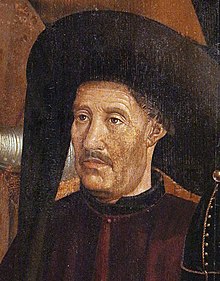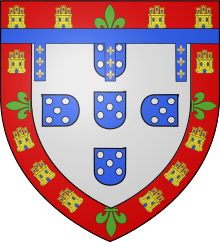Henry the Navigator

Henry the Navigator (born March 4, 1394 in Porto , † November 13, 1460 in Sagres ; Portuguese Infante Dom Henrique de Avis , called O Navegador ) was the initiator, patron and commissioner of the Portuguese voyages of discovery in the first half of the 15th century. The voyages of discovery he initiated along the West African coast established the Portuguese maritime and colonial power and marked the beginning of European expansion .
Life
Heinrich was the fourth son of the Portuguese King John I and his wife Philippa of Lancaster , brother of Ferdinand the Holy and the Portuguese King Edward I. In 1415 a fleet under his leadership conquered the North African city and fortress of Ceuta . For this he was made Duke of Viseu . From 1420 he was the secular administrator of the Order of Christ . Royal descent and his offices gave him considerable financial resources, which he used to promote seafaring. In 1437 he commanded another campaign to snatch Tangier from the Moors , this time unsuccessfully.
In the years 1427 to 1432 Henry's ships discovered and settled the Azores . Then Heinrich set about bringing the Canary Islands into Portuguese possession. To do this, he first took the diplomatic route by asking Castile to grant Portugal the right to occupy this group of islands. When this did not work - Castile insisted on its sovereignty over the islands - Henry's brother King Edward turned to the Pope and the Pope , obviously ignorant of the Castilian claims, complied with Edward's request. John II of Castile immediately raised an objection through his ambassador. Thereupon the Pope made it clear that he had given the Portuguese permission to conquer the Canary Islands only on condition that no other Christian prince could lay claim to it.
- In 1419 Madeira and
- In 1427 the Azores (re) discovered and colonized by Portugal.
- His father, King John I, died in 1433 .
- King Eduard (Duarte) died of the plague in 1438 , and Peter of Coimbra reigned for his underage son .
- In 1445, a Portuguese trading post was opened in Arguim in Africa , and Portugal began trading in African slaves .
Heinrich himself did not go on expeditions. He owes his nickname to his commitment as a promoter of seafaring. He was very well read and knew the reports of earlier explorers to Asia such as Marco Polo , Wilhelm von Rubruk or the Arab world traveler Ibn Battuta .
The fact that he founded a nautical academy ( escola náutica ) is an invention of later centuries that Portuguese historians have not represented for a long time.
The voyages of discovery
As governor of the Algarve , Heinrich initiated an ambitious program to open up a sea route to India from 1418 .
The prince initiated numerous voyages of discovery along the African coast, which were mainly carried out with ships of the caravel type . The knowledge gained in navigation , cartography and shipbuilding was fundamental for all subsequent Portuguese voyages of discovery. From the beginning, the Portuguese pilots and captains were obliged to record in secret logbooks, the Roteiros , all the experiences and knowledge they had gathered on their voyages and which were important for navigation . In the second half of the 15th century, the Portuguese were already using the quadrant : by determining the height of the North Star , the geographical latitude could be calculated. By the time the Infante died, more than 2000 nautical miles of West African coastal waters had been navigated and mapped.
Heinrich the Navigator's motives were varied. On the one hand, it was hoped to bypass or eliminate the Arabs in the trade in pepper , gold , ivory and slaves , and on the other hand, the prince wanted to promote and spread the Christian faith. They searched for the legendary Christian priest-king Johannes , who was suspected to be in Asia, sometimes in Africa even before the time of Henry the Navigator. With its help one wanted to push back Islam . These ideas gave way to commercial considerations during his lifetime .
38 years after Heinrich's death, his preliminary work led to the discovery of the sea route to India by Vasco da Gama and the strengthening of Portugal in the Indian trade , to the development of the sea route around Africa to rear India and thus to Portugal's position as a world power .
Casa da India
The Casa da Índia was both the central authority for the administration of all overseas territories of the Kingdom of Portugal and the central trading point and clearing house for all areas of overseas trade. As an economic institution, it functioned like a trading post or a trading establishment.
The forerunners of the Casa da Índia emerged in the wake of the Portuguese voyages of discovery along the African coasts and the associated trading opportunities. The Casa de Ceuta was founded in Lisbon as early as 1434 . However, it was not very successful because after the Portuguese conquest of Ceuta in 1415, the trade routes and flows of goods connected with the city moved to other places. Around 1445, the Casa de Arguim and de Guiné were founded in Lagos on the Algarve , both of which, also known as Companhia de Lagos , served the development of Portuguese trade with West Africa . After the death of Henry the Navigator, both houses were moved to Lisbon in the sixties of the 15th century and later merged into the Casa da Guiné e da Mina .
Important discoveries under Henry the Navigator
During landings on their voyages of discovery, the captains were obliged to set up a so-called padrão (a stone column with the coat of arms of the Portuguese king and inscriptions) that they had brought on board . At prominent, newly discovered points such as capes or estuaries, the captains had to chisel names and dates into the stone under the Christ cross and the coat of arms of Portugal .
- In 1418 João Gonçalves Zarco , Bartolomeu Perestrelo and Tristão Vaz Teixeira rediscover the island of Porto Santo , which belongs to Madeira .
- In 1420 the Portuguese land on the actual main island Madeira and around 1425 decide to settle the archipelago.
- In 1422 Portuguese seafarers advance south via Cabo Nao , the border area of Arab seafaring in the Atlantic.
- In 1427 Diogo de Silves is said to have rediscovered the Azores . He probably went ashore on the island of Santa Maria on the way back from a scouting expedition in the Atlantic .
- In 1431 the settlement and colonization of the Azores began under Gonçalo Velho Cabral .
- In 1434, Captain Gil Eanes sailed around Cape Bojador, which was considered impassable .
- In 1436 the captains Gil Eanes and Afonso Gonçalves discovered Baldaia Angra dos Ruivos and reached Río de Oro .
- In 1441 the first caravel was built in Lagos on Heinrich's instructions .
- In 1441 Nuno Tristão and Antão Gonçalves reached Cape Blanc (Portuguese: Cabo Branco).
- In 1444 Nuno Tristão sailed the Senegal River ; In the same year happened Dinis Dias the westernmost point of continental Africa, which in today's Senegal situated Cabo Verde , and discovered the Terra dos Guineus , areas of present-day Guinea and Senegal.
- In 1444/1445 the Companhia de Lagos is founded, which receives the trade monopoly with Africa.
- In 1446 the Gambia River was discovered.
- In 1446 Andrea Bianco created a map that made a Portuguese expedition into the western Atlantic appear possible.
- In 1455/1456 the Venetian Alvise Cadamosto , who was in the service of Heinrich, advanced to the Guinea coast and discovered two of the Cape Verde Islands .
- In 1460 the brothers Bartolomeo and Antonio da Noli , who come from the Republic of Genoa , explore and colonize Cape Verde.
- In 1460, at the death of the Infante Heinrich the Navigator, the Portuguese navigated and mapped the African coast up to today's Sierra Leone (approx. 8 ° N) and the Atlantic to the Sargasso Sea (approx. 40 ° W).
Monuments

A statue can be seen in the Padrão dos Descobrimentos near Lisbon; this was built 500 years after his death.
In the Portuguese city of Lagos , a monument to Heinrich has stood on the Praça da República (Republic Square; also called Praça do Infante Henrique) since 1960.
The capital of East Timor , Dili , honors Heinrich with a monument in front of the government palace .
See also
- Seafaring , seafarers
- Portuguese colonial history
- Order of the Infante Dom Henrique
- Development history of the nautical chart
- History of Portugal , Timeline of Portugal , Portugal under the House of Avis
literature
- Luís de Albuquerque: Os 'Sábios' Henriquinos ea 'Escola de Sagres'. In: Luís de Albuquerque: Dúvidas e Certezas na História dos Descobrimentos Portugueses. Vol. 1, Vega, Lisbon 1990, pp. 15-28.
- Rudolf Kroboth (ed.): Heinrich the seafarer. Edition Erdmann, Stuttgart 1989, ISBN 978-3-522-61180-0 .
- Duarte Leite: O infante D. Henrique. In: Duarte Leite: História dos Descobrimentos. Vol. 1, Lisbon 1959, pp. 67-265.
- José António Madeira: Estudo Histórico-Científico, sob o Aspecto Gnómico, da Figura Radiada de Pedra Tosca Suposta Coeva do Infante D. Henrique Existente em Sagres. In: Actas do Congresso Internacional de História dos Descobrimentos. Vol. 2, Lisbon 1961, pp. 451-474.
- Alfredo Pinheiro Marques: Portugal eo descobrimento do Atlântico. Imprensa Nacional, Casa da Moeda, Lisbon 1990, ISBN 972-27-0426-5 .
- WGL Randles: The Alleged Nautical School Founded in the Fifteenth Century at Sagres by Prince Henry of Portugal, Called the 'Navigator'. In: Imago Mundi. 45, 1993, pp. 20-28.
- Peter E. Russell: Prince Henry 'the Navigator'. A life. Yale University Press, New Haven 2000, ISBN 0-300-08233-9 .
Web links
- Literature about Heinrich the seafarer in: Catalog Ibero-American Institute in Berlin
- Portugal and the discovery of the New World. TravelWorldOnline.de
- Cronologia de Algumas Viagens de Descobrimento. Associação Nacional de Cruzeiros (Portuguese) ( Memento from November 22, 2012 in the Internet Archive )
- Jörg Beuthner: 04.03.1394 - Birthday of Heinrich, the seafarer WDR ZeitZeichen from March 4th, 2014 (podcast)
Individual evidence
- ^ Walter Zöllner in: Biographies for world history. Deutscher Verlag der Wissenschaften , Berlin 1989, p. 235.
- ↑ Alfonso García-Gallo de Diego: Las bulas de Alejandro VI y el ordenamiento jurídico de la expansión portuguesa y castellana en Africa e Indias . In: Anuario de historia del derecho español . No. 27-28 , 1957, pp. 485 ff . (Spanish, available online [accessed July 20, 2016]).
| personal data | |
|---|---|
| SURNAME | Henry the Navigator |
| ALTERNATIVE NAMES | Dom Henrique o Navegador |
| BRIEF DESCRIPTION | Prince of Portugal from the House of Avis |
| DATE OF BIRTH | March 4, 1394 |
| PLACE OF BIRTH | postage |
| DATE OF DEATH | November 13, 1460 |
| Place of death | Sagres |


